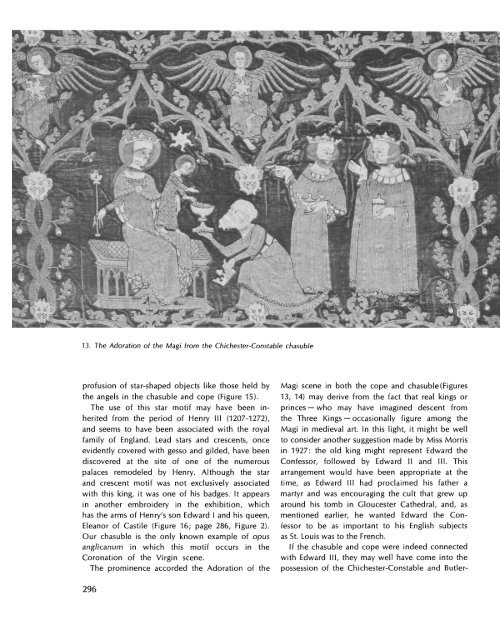The Metropolitan Museum of Art Bulletin, v. 29, no. 7 (March, 1971)
The Metropolitan Museum of Art Bulletin, v. 29, no. 7 (March, 1971)
The Metropolitan Museum of Art Bulletin, v. 29, no. 7 (March, 1971)
Create successful ePaper yourself
Turn your PDF publications into a flip-book with our unique Google optimized e-Paper software.
13. <strong>The</strong> Adoration <strong>of</strong> the Magi from the Chichester-Constable chasuble<br />
pr<strong>of</strong>usion <strong>of</strong> star-shaped objects like those held by<br />
the angels in the chasuble and cope (Figure 15).<br />
<strong>The</strong> use <strong>of</strong> this star motif may have been inherited<br />
from the period <strong>of</strong> Henry 111 (1207-1272),<br />
and seems to have been associated with the royal<br />
family <strong>of</strong> England. Lead stars and crescents, once<br />
evidently covered with gesso and gilded, have been<br />
discovered at the site <strong>of</strong> one <strong>of</strong> the numerous<br />
palaces remodeled by Henry. Although the star<br />
and crescent motif was <strong>no</strong>t exclusively associated<br />
with this king, it was one <strong>of</strong> his badges. It appears<br />
in a<strong>no</strong>ther embroidery in the exhibition, which<br />
has the arms <strong>of</strong> Henry's son Edward I and his queen,<br />
Elea<strong>no</strong>r <strong>of</strong> Castile (Figure 16; page 286, Figure 2).<br />
Our chasuble is the only k<strong>no</strong>wn example <strong>of</strong> opus<br />
anglicanum in which this motif occurs in the<br />
Coronation <strong>of</strong> the Virgin scene.<br />
<strong>The</strong> prominence accorded the Adoration <strong>of</strong> the<br />
Magi scene in both the cope and chasuble(Figures<br />
13, 14) may derive from the fact that real kings or<br />
princes-who may have imagined descent from<br />
the Three Kings-occasionally figure among the<br />
Magi in medieval art. In this light, it might be well<br />
to consider a<strong>no</strong>ther suggestion made by Miss Morris<br />
in 1927: the old king might represent Edward the<br />
Confessor, followed by Edward II and II1. This<br />
arrangement would have been appropriate at the<br />
time, as Edward III had proclaimed his father a<br />
martyr and was encouraging the cult that grew up<br />
around his tomb in Gloucester Cathedral, and, as<br />
mentioned earlier, he wanted Edward the Confessor<br />
to be as important to his English subjects<br />
as St. Louis was to the French.<br />
If the chasuble and cope were indeed connected<br />
with Edward III, they may well have come into the<br />
possession <strong>of</strong> the Chichester-Constable and Butler-<br />
<strong>29</strong>6

















